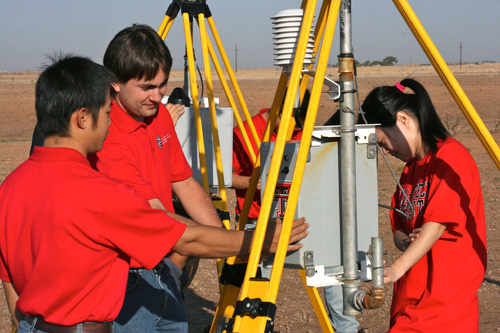Educating Wind Energy Workers: A multi-disciplinary approach
 For the United States to meet its federal goal of 20% wind power by 2030, universities across the nation need to establish education programs to train students entering the wind energy industry. Without incumbent workers and students with multi-disciplinary backgrounds—ranging from business to engineering to atmospheric science—most companies may not be able to successfully expand their workforce to meet this energy goal.
For the United States to meet its federal goal of 20% wind power by 2030, universities across the nation need to establish education programs to train students entering the wind energy industry. Without incumbent workers and students with multi-disciplinary backgrounds—ranging from business to engineering to atmospheric science—most companies may not be able to successfully expand their workforce to meet this energy goal.
Many of the issues the wind power industry encounters cross multiple sectors within certain disciplines, such as mechanical, electrical, and civil engineering. However, specific issues within engineering impact or are impacted by other disciplines, such as atmospheric science, business, and political science. To better appreciate how a change in a specific field impacts the broader scope, it’s important to first understand the links between multiple disciplines. A multi-disciplinary education program is, therefore, required for the industry to grow quickly, without suffering any major setbacks.
Assessing standards
Traditionally in academia, wind-related programs offer either a wind engineering or a wind science approach. The concept of a silo, or single discipline, education program offers a limited perspective to the many dynamics of wind energy. Students who understand how specific engineering concepts can impact legal and financial agreements maintain a competitive advantage over those students from a silo program, especially when it comes to applying for a job or working at a jobsite.
A comprehensive education program should be firmly founded on a long-term history in wind science and engineering. The program should consist of courses from an atmospheric science and wind engineering perspective. A complete understanding of how complex atmospheric conditions change and impact wind engineering principals is critical not only for designing a successful wind farm, but also for identifying contributing factors related to wind farm failures. Students should also graduate with an understanding of how and why a windstorm forms, how it can affect a wind farm’s structures, as well as a wind farm’s revenue bottom line, which is critical for success in the industry.
Ideally, a comprehensive multidisciplinary education program would include courses in the following areas, specifically designed to meet the growing wind industry:
• Atmospheric science
• Business
• Construction technology
• Civil, mechanical, and electrical engineering
• Economics
• Law
• Mathematics
• Political science
Currently, most wind energy education programs in the US are based within a certain department, within a specific school. Sometimes education programs in specific departments, however, face challenges in terms of providing students with a broader understanding of the wind industry. This can be due to course length, training principles, or internal university politics. Regardless of the reasons, for a multi-disciplinary program to be effective, it’s important to consider the quality of the course work, as well as the breadth of a program.
Starting at the top
A multi-tiered education program is not only critical for increasing the value of future workers in the industry, but it’s also essential in terms of providing students with continued access to accelerate their education. Ideally, degrees for a Bachelor’s, Master’s and PhD in wind energy would be established to support the evolution of wind energy education. However, this can be difficult to create, as starting any educational program from scratch is a challenge at most universities. Not only are there cost and enrollment issues, but also various departments or colleges commonly attempt to absorb new programs (often using existing faculty to claim student enrollments). For example, wind engineering courses are usually held within a university’s College of Engineering, while atmospheric science typically resides within the College of Arts and Science.
By offering students the opportunity to obtain a degree, universities could play an integral role in increasing education standards and student marketability. Beforehand, however, it would make sense to create a PhD program. In doing so, a university could begin building courses that are specifically tailored to educate students.
Universities should only begin a Bachelor’s course once a critical mass of research and course work in wind energy is achieved at the school. Without this research, coursework, and a developed PhD program, a Bachelor’s degree program may not prove successful. Student enrollment is critical for the success of a Bachelor’s program as it is often the main funding source for an undergraduate program. Usually, this degree does have substantially more student enrollments than PhD programs and, therefore, requires established coursework and competent teaching assistances (TA’s) to support the massive instruction load. Qualified and committed TA’s are hard to find—but are often created by notable PhD programs.
Thinking outside the box
Perhaps one of the best or only ways to create a multi-disciplinary degree in wind energy is to design an education program outside of an existing college or school. But this program would need a baseline faculty group to teach, and to ensure critical courses are offered and sustained. This proposed structure would allow students obtaining a degree in engineering or science to double-major, minor, or take additional courses to prepare them for work in wind and related industries. This structure also gives students the unique capability to tailor their education to meet career goals. For example, if a student wants to design wind turbines, it would be possible for him or her to obtain a major in the engineering college, while receiving a major, minor, or certificate in wind energy—thereby receiving a well-rounded, multi-disciplinary education in wind energy.
Note: Texas Tech University has formed the National Wind Institute (NWI), which offers a multi-disciplinary research and education program. NWI has 40 years of history in Wind Science and Engineering, and currently offers the only PhD program in wind science and engineering in the US, as well as the only Bachelor’s degree program in wind energy (www.depts.ttu.edu/nwi).
Group NIRE
www.groupnire.com
Author: Anna Young & Mark Harral
Volume: July/August 2013








